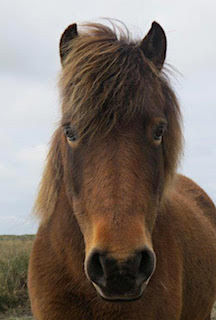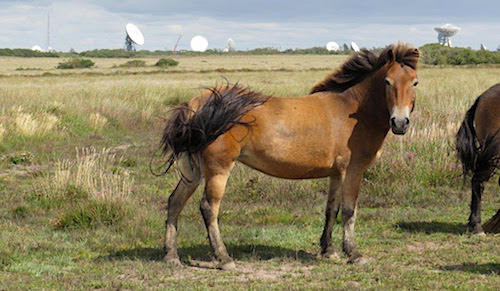 This tough pony is another of our hard-working grazers, helping to conserve the heathland and coastal habitats of The Lizard.
This tough pony is another of our hard-working grazers, helping to conserve the heathland and coastal habitats of The Lizard.
Photo: Steve Townsend
Scientific name: Equus ferus caballus (the scientific name for the domestic horse, of which Exmoor Ponies are a breed)
Cornish name: Hoba is the Cornish word for a pony
Status: Given “endangered” status by the UK Rare Breeds Survival Trust
What to look for:
- Appearance and colouring: Brown (dark bay), with what are called ‘pangaré’ markings (paler areas) on the muzzle, flanks and belly.
- Size: 114 to 130 cm (11.1 to 12.3 hands)
- Where: Free-roaming on Exmoor, where they are semi-feral managed herds, and also elsewhere, used in conservation grazing and in other functions.
 When out for an invigorating walk on one of our nature reserves, you may well come across our ponies, who have an important role to play in preserving biodiversity and The Lizard’s rare fauna and flora.
When out for an invigorating walk on one of our nature reserves, you may well come across our ponies, who have an important role to play in preserving biodiversity and The Lizard’s rare fauna and flora.
One of these pony breeds is the Exmoor Pony. Strong and hardy despite its small stature, it is well-suited to the tough conditions you might encounter on The Lizard. This makes it a perfect breed for conservation grazing, but its adaptability and resilience means you can find Exmoors in a variety of roles, from teaching children to ride, to winning competitions as driving ponies.
In the past, Exmoors were bred on the moorlands of Devon and Somerset to cope with the wild upland conditions, supporting farmers and shepherds. They have a broad back and short, strong-boned legs. Their teeth, with a firm, clean bite, are adapted to eating the tough heathland vegetation that other grazers might reject. They are sturdy enough to stay outside throughout the harsh winter, helped by their thick winter coat: this is two-layered, with a warm under layer of woolly hairs, and a top layer of oily hairs that provide excellent waterproofing.
 The paler markings (called ‘pangaré’ markings) on the breed’s muzzle, belly, and flanks contrast with its dark bay coat; these markings are in fact a primitive equine trait, evidence of the Exmoor Pony’s long history as a breed, and the closeness to its origin as a descendant of wild horses.
The paler markings (called ‘pangaré’ markings) on the breed’s muzzle, belly, and flanks contrast with its dark bay coat; these markings are in fact a primitive equine trait, evidence of the Exmoor Pony’s long history as a breed, and the closeness to its origin as a descendant of wild horses.
Exmoor Ponies as a breed nearly did not survive the twentieth century. Exmoor was used as an army training ground in the Second World War, and many were sadly shot for target practice, or killed for their meat; only 50 were left by the end of the War. A determined group of breeders set about reviving the population, and, although still considered “threatened” and “endangered” by the Livestock Conservancy and UK Rare Breeds Survival Trust, respectively, the Exmoor Pony is once again finding its niche in our lives and hearts.
Did you know…?
…Our word pony comes from the French word for a foal – poulenet.
…Horse and pony species have been in the British Isles since 700,000 BC; equine fossil remains on Exmoor date back to 50,000 BC, and ponies on Exmoor are mentioned in the Domesday Book, in 1086.

Published: December 2017
Author: Amanda Scott
Photos: Steve Townsend
